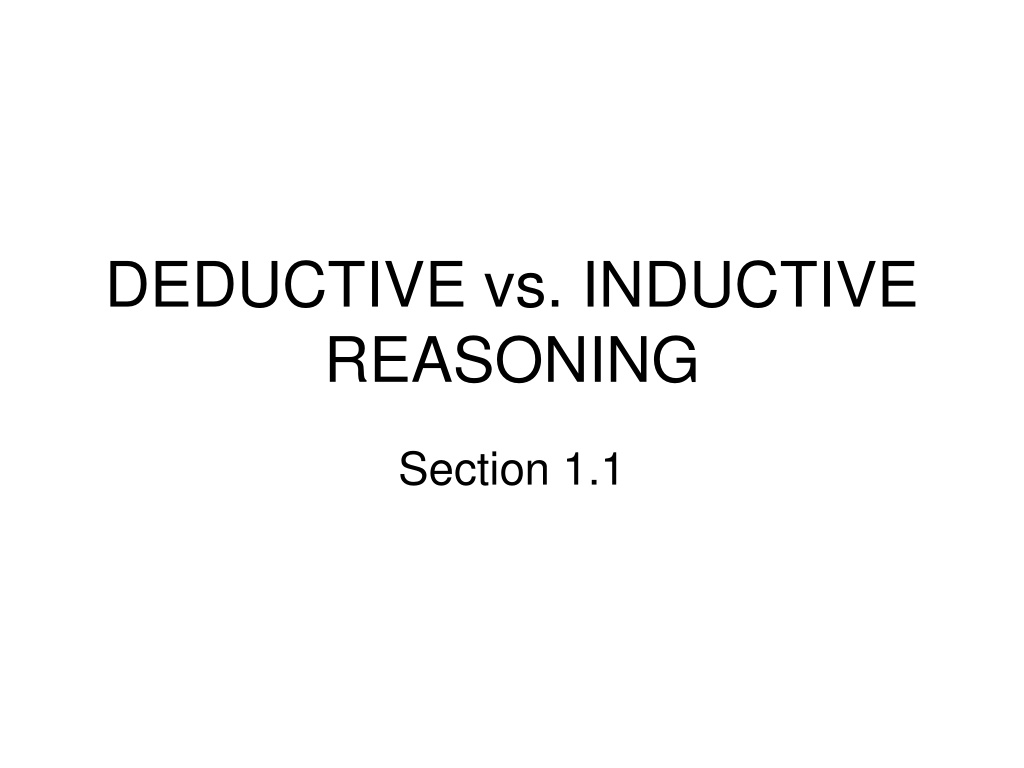Understanding Deductive Reasoning and Problem Solving in Logic
Explore the concepts of deductive reasoning, problem-solving logic, and Venn diagrams in this informative content. Learn about the process of drawing conclusions from known facts, using syllogisms to make valid arguments, and understanding the difference between truth and validity in deductive reasoning. Dive into examples and illustrations to enhance your grasp of logical reasoning techniques.
Download Presentation

Please find below an Image/Link to download the presentation.
The content on the website is provided AS IS for your information and personal use only. It may not be sold, licensed, or shared on other websites without obtaining consent from the author. Download presentation by click this link. If you encounter any issues during the download, it is possible that the publisher has removed the file from their server.
E N D
Presentation Transcript
DEDUCTIVE vs. INDUCTIVE REASONING Section 1.1
Problem Solving Logic The science of correct reasoning. Reasoning The drawing of inferences or conclusions from known or assumed facts. When solving a problem, one must understand the question, gather all pertinent facts, analyze the problem i.e. compare with previous problems (note similarities and differences), perhaps use pictures or formulas to solve the problem.
Deductive Reasoning Deductive Reasoning A type of logic in which one goes from a general statement to a specific instance. The classic example All men are mortal. (major premise) Socrates is a man. (minor premise) Therefore, Socrates is mortal. (conclusion) The above is an example of a syllogism.
Deductive Reasoning Syllogism: An argument composed of two statements or premises (the major and minor premises), followed by a conclusion. For any given set of premises, if the conclusion is guaranteed, the arguments is said to be valid. If the conclusion is not guaranteed (at least one instance in which the conclusion does not follow), the argument is said to be invalid. BE CARFEUL, DO NOT CONFUSE TRUTH WITH VALIDITY!
Deductive Reasoning Examples: 1. All students eat pizza. Claire is a student at ASU. Therefore, Claire eats pizza. 2. All athletes work out in the gym. Barry Bonds is an athlete. Therefore, Barry Bonds works out in the gym.
Deductive Reasoning 3. All math teachers are over 7 feet tall. Mr. D. is a math teacher. Therefore, Mr. D is over 7 feet tall. The argument is valid, but is certainly not true. The above examples are of the form If p, then q. (major premise) x is p. (minor premise) Therefore, x is q. (conclusion)
Venn Diagrams Venn Diagram: A diagram consisting of various overlapping figures contained in a rectangle called the universe. U A B This is an example of all A are B. (If A, then B.)
Venn Diagrams This is an example of No A are B. A B U
Venn Diagrams This is an example of some A are B. (At least one A is B.) The yellow oval is A, the blue oval is B.
Example Construct a Venn Diagram to determine the validity of the given argument. #14 All smiling cats talk. The Cheshire Cat smiles. Therefore, the Cheshire Cat talks. VALID OR INVALID???
Example Valid argument; x is Cheshire Cat Smiling cats Things that talk x
Examples #6 No one who can afford health insurance is unemployed. All politicians can afford health insurance. Therefore, no politician is unemployed. VALID OR INVALID?????
Examples X=politician. The argument is valid. Politicia ns X Unemplo yed People who can afford Health Care.
Example #16 Some professors wear glasses. Mr. Einstein wears glasses. Therefore, Mr. Einstein is a professor. Let the yellow oval be professors, and the blue oval be glass wearers. Then x (Mr. Einstein) is in the blue oval, but not in the overlapping region. The argument is invalid.
Inductive Reasoning Inductive Reasoning, involves going from a series of specific cases to a general statement. The conclusion in an inductive argument is never guaranteed. Example: What is the next number in the sequence 6, 13, 20, 27, There is more than one correct answer.
Inductive Reasoning Here s the sequence again 6, 13, 20, 27, Look at the difference of each term. 13 6 = 7, 20 13 = 7, 27 20 = 7 Thus the next term is 34, because 34 27 = 7. However what if the sequence represents the dates. Then the next number could be 3 (31 days in a month). The next number could be 4 (30 day month) Or it could be 5 (29 day month Feb. Leap year) Or even 6 (28 day month Feb.)























